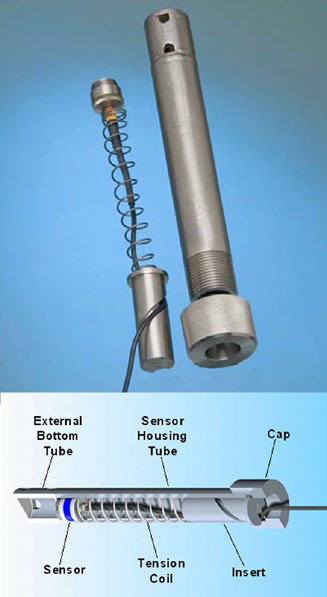Tech Briefs
Savannah River National Laboratory
Self-Targeting Ultrasonic Liquid Level Probe
A researcher at the Savannah River Site has developed a device to address a unique application involving the precise filling of drums containing hazardous liquids. Unlike an aircoupled probe that measures headspace, this device transmits an ultrasonic beam capable of penetrating metals and liquids. The transducer is mounted outside of the pressure boundary and is therefore protected from the hazardous liquid.
Background
An ultrasonic transducer is mounted on the “dry” side of a dual chamber well with the beam directed at a “target” located at the far end of the flooded or “wet” side. Internal spring loading maintains a constant level of pressure on the transducer and eliminates air gaps at the interface. When the wet side becomes fully flooded during filling operations, an ultrasonic wave is transmitted through the liquid where it reaches and is reflected by the target returning the wave back to the transducer. The vented chamber allows for any air or gas to be readily displaced by the rising liquid. Once the desired liquid level has been reached, detection of the reflected wave generates a real time response on the test instrument where it can be readily observed with LED indicators and an audible alarm. In addition, an optional shielded plug has been developed to reduce or eliminate gamma radiation exposure to personnel.

At a glance
- U.S. patent 7,802,470
- Protected ultrasonic transducer
- Top, side, bottom mount without signal loss
- Penetrates metals or liquids
- Audible alarm and LED indicators
- Reduces or eliminates personnel exposure
Design features
The incorporated target reflector provides perpendicularity with respect to primary beam and minimizes travel to reduce attenuation. Use of the target as the primary reflector instead of the bottom of the tank or drum minimizes the signal dampening or attenuation effect of any sediment or sludge that may be present, and eliminates any alignment concern. This device can be mounted at the top or side of the drum or vessel, or from the bottom using signal loss as a level indicator.
Partnering opportunities
SRNL invites interested companies with proven capabilities in this area of expertise to enter into a licensing agreement with SRNL to market this nuclear material detection system. Interested companies will be requested to submit a business plan setting forth company qualifications, strategies, activities, and milestones for commercializing this invention.
Qualifications should include past experience at bringing similar products to market, reasonable schedule for product launch, sufficient manufacturing capacity, established distribution networks, and evidence of sufficient financial resources for product development and launch.
Download Tech Brief
Contact Information
Savannah River National Laboratory
E-mail: partnerships@srnl.doe.gov